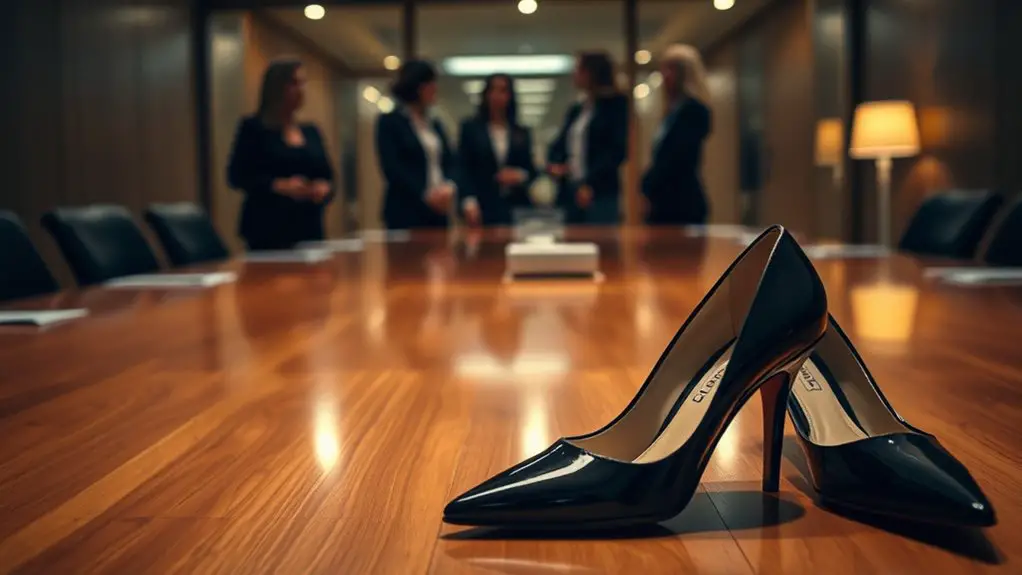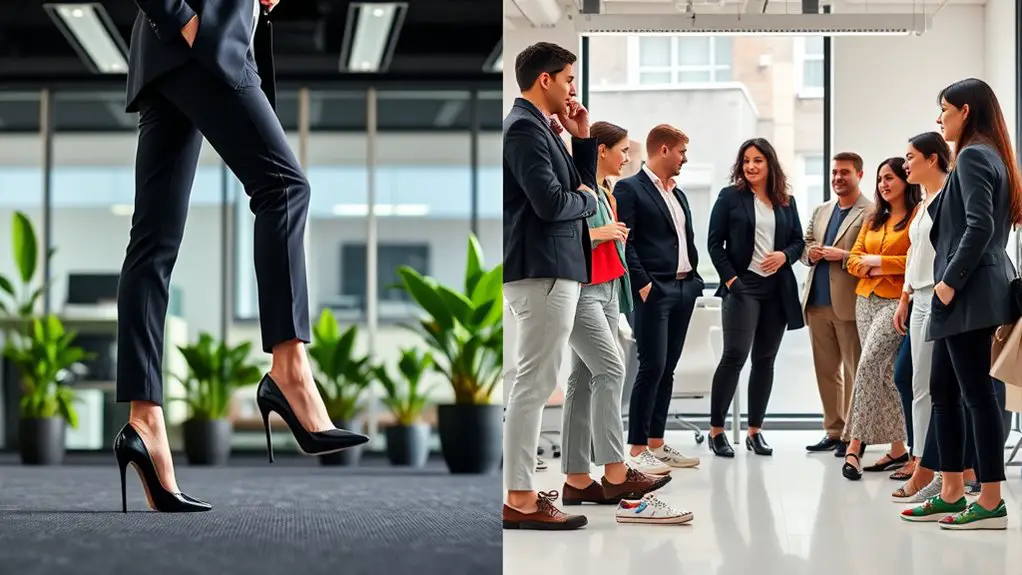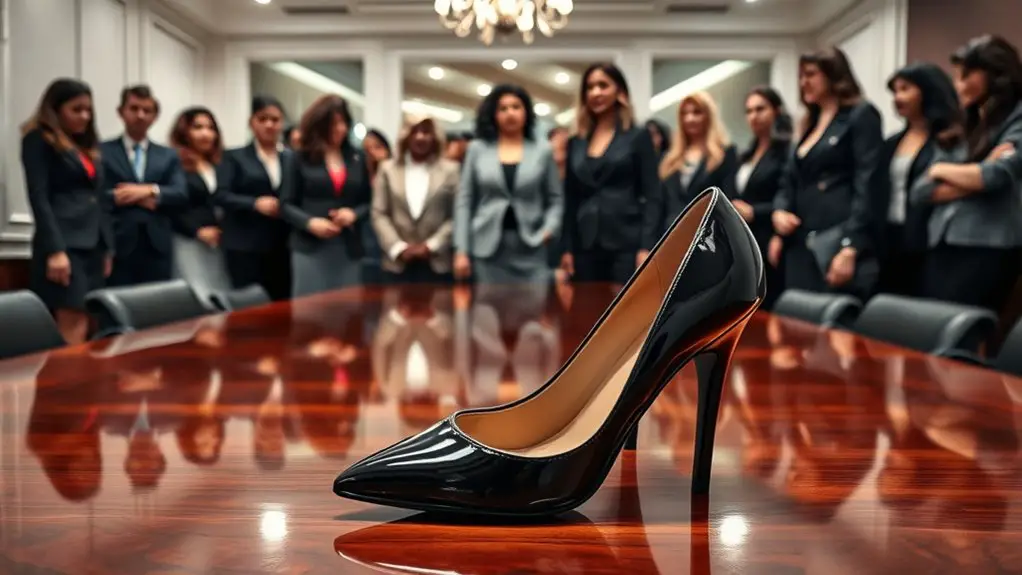The debate on mandatory high heels in professional settings questions whether outdated dress codes should dictate your comfort. Heels can lead to serious health issues, reducing your productivity and well-being. Plus, they often stifle your individuality and self-expression at work. While some argue they project authority, many believe it’s time to embrace diverse styles that reflect modern values. Want to discover how workplaces are evolving to prioritize inclusivity and choice?
Historical Context of Dress Codes in the Workplace

While you might think dress codes are a modern phenomenon, they’ve actually been shaping professional environments for centuries. From the tailored suits of the early 20th century to the more relaxed styles of today, historical dress has always reflected societal values and expectations. As workplaces evolved, so did the norms surrounding attire, often dictating what’s deemed acceptable or professional.
In corporate settings, a polished appearance was once synonymous with competence and authority. This notion has been deeply ingrained in workplace culture, influencing how you present yourself. But as the lines blur between formality and comfort, the conversation around dress codes is shifting. You might find that understanding this historical context can empower you to challenge outdated norms and advocate for a more inclusive environment. Embracing this evolution is key, not just for personal expression but for fostering a workplace that values individuality over conformity.
The Impact of High Heels on Women’s Health and Comfort
Although high heels are often seen as a fashion statement in professional settings, they can have a significant impact on women’s health and comfort. When you slip on those stilettos, you might feel empowered, but your foot health can take a serious hit. The elevation forces your body into an unnatural position, leading to issues like bunions, plantar fasciitis, and even lower back pain.
Imagine being at work, struggling to concentrate while your feet ache. Comfort levels plummet, affecting not just productivity but your overall well-being. It’s time to reconsider what “professional” really means. Shouldn’t it include the freedom to feel good while you work? Embracing more comfortable footwear options doesn’t just support your feet; it can boost your confidence and performance too. So, next time you choose your outfit, think about the true cost of those high heels on your health and comfort.
Perspectives From the Business World: Professionalism vs. Individuality

The debate around mandatory high heels in the workplace raises important questions about professionalism and individuality. You’ve likely felt the pressure to conform to dress norms that define corporate identity. But what if those norms stifle your true self? Companies often argue that high heels project authority and elegance, but isn’t professionalism more about confidence and authenticity?
When you express your individuality through your choice of footwear, you challenge outdated norms and redefine what it means to look professional. High heels might be seen as a status symbol, but they can also be a burden. Embracing diverse styles not only reflects a modern workplace but also fosters a culture of inclusivity.
In a world where self-expression is celebrated, why should anyone be forced to compromise their comfort for a pair of heels? It’s time for businesses to rethink their dress codes and prioritize both professionalism and individuality.
Legal Implications and Gender Discrimination in Dress Codes
As companies enforce dress codes that require high heels, they inadvertently tread into the murky waters of gender discrimination. This practice not only raises eyebrows but also brings potential legal ramifications that can’t be ignored. When you mandate specific footwear for women, you’re fundamentally placing them in a box, reinforcing outdated gender bias that can affect their career progression and workplace comfort.
Imagine a male colleague showing up in smart, comfortable shoes while you’re struggling in heels—how’s that fair? Legal experts argue that such dress codes could violate equal employment opportunity laws, as they create an uneven playing field based on gender.
It’s time to rethink these policies. By enforcing mandatory high heels, companies risk not only their reputations but also face the possibility of lawsuits. In a world aiming for equality, why should your footwear choices be dictated by outdated norms? Let’s advocate for a workplace that values comfort and individuality over archaic expectations.
The Future of Workplace Fashion: Towards Inclusivity and Choice

Mandatory high heels have sparked a conversation about the future of workplace fashion, pushing us toward a more inclusive and choice-driven environment. You deserve to express your individuality while promoting workplace diversity, and that means breaking free from outdated dress codes.
Here’s how fashion expression can evolve in the workplace:
| Inclusivity | Fashion Expression |
|---|---|
| Embrace diverse styles | Celebrate personal choices |
| Offer comfort options | Allow casual attire |
| Promote gender-neutral wear | Support cultural attire |
| Encourage self-expression | Value creativity over conformity |
| Foster a supportive community | Recognize individuality |
As we redefine office attire, let’s prioritize comfort and self-expression for everyone. When you feel good in what you wear, your confidence soars, ultimately enhancing productivity and workplace culture. It’s time to champion a fashion-forward approach that embraces choice!
Frequently Asked Questions
What Are Some Alternative Footwear Options That Maintain Professionalism?
When considering professional footwear, you can opt for comfortable flats or stylish sneakers. They provide a chic look while ensuring you’re comfortable throughout the day, proving that professionalism doesn’t have to sacrifice your comfort or style.
How Do Different Cultures View High Heels in Professional Settings?
Cultural perceptions of high heels vary widely; in some places, they symbolize professionalism and empowerment, while elsewhere, they reinforce outdated gender expectations. You’ve gotta consider these nuances when maneuvering your own professional style choices!
Are There Industries Where High Heels Are More Common?
In industries like fashion and hospitality, high heels are common due to fashion trends and corporate expectations. You’ll find they often symbolize sophistication, but remember, comfort and personal style are just as important in any workplace.
What Do Surveys Say About Employee Preferences on Dress Codes?
Surveys show employee satisfaction skyrockets when dress code flexibility’s on the table. Who wouldn’t want to swap stiff suits for comfy sweats? It’s time to ditch the outdated norms and embrace a more relaxed workplace vibe!
How Have Social Media Influencers Impacted Views on Professional Attire?
Social media influencers have revolutionized professional attire perceptions, showcasing diverse fashion trends that challenge traditional norms. Their unique styles inspire you to embrace individuality, encouraging a shift towards more comfortable, yet stylish, workplace fashion choices.



